Love and hate in the express lane
April 24, 2014
When it was time for the public to finally be heard on Los Angeles’ new freeway toll lanes, Metro got an earful.
“I love the Metro Express Lanes!!!!! We should have them throughout the city.”
“These fast track lanes have turned into nothing but Lexus Lanes.”
“Express Lanes are the best thing ever to happen to Los Angeles freeways.”
“The Express Lane program is an absolute joke.”
“Please Please Please…expand the express lanes!!!!!!
“ADMIT IT—IT’S A FAILURE!!!!
Metro had asked for the public’s take in March as part of a broad analysis to help the agency’s board of directors determine whether the “high occupancy toll lanes” on two of Los Angeles’ busiest freeways—the 110 and 10—should be made permanent. And on Thursday, the directors gave a unanimous thumbs-up to extending the experiment, despite the deeply divided motoring public reflected in the more than 700 emails the agency received.
The federally-funded program lets solo drivers, who pay a toll, share lanes with carpoolers, who can continue to drive in them for free, with one important and controversial caveat: everyone must have an electronic device called a transponder to use the “ExpressLanes.” That requires putting $40 into a “pre-paid” toll account, unless a person’s income qualifies him or her for assistance.
Stephanie Wiggins, Metro’s executive in charge of the toll lanes, presented the analysis to the board on Thursday. She said in an interview that she’s “never, never, never” had a job that has attracted so much public heat. “People really love them,” Wiggins said of the new lanes, “or they really hate them. There’s no in-between.” By overwhelming majorities, according to a Metro survey, those who obtained transponders are happy and those who didn’t are not.
Metro director Mike Bonin, who also is a member of the Los Angeles City Council, lauded the pilot program but acknowledged, like others on the board, that it is still a work in progress. “We’re in the breaking eggshells phase of making an omelet,” he said.
It’s not surprising, of course, that the dramatic changes would generate consternation and confusion among motorists who for decades have been freely using the carpool lanes—for 39 years on the 10, east of downtown Los Angeles, and 15 years on the 110, which slices through the heart of the city.
Statistical measures compiled by federal transportation officials in advance of the board’s vote have done little to settle the debate. They can be used by either side to make a glass-half-full/half-empty argument.
The pilot program was intended to improve traffic flow in both the toll and “general purpose,” or free, lanes, while also encouraging the use of transit alternatives, such as the Silver Line buses that travel along the toll lanes. So far, bus ridership has jumped but traffic times are not much different than before the experiment, according to a recent analysis by an independent firm hired by the Federal Highway Administration. Some drive times are slightly faster since the tolls went into effect, while others are slower, depending on the specific hours studied during peak morning and afternoon traffic.
Wiggins acknowledged that “the numbers, on their face, look marginal.” But she said there’s a clear bright spot, too: Solo drivers who’ve moved from the free lanes into the toll lanes have saved more than 17 minutes on some of their drives. And for those who haven’t changed their behaviors and remain in the free lane, they’re not really any worse off than they were before, she said. “And that can be perceived as a positive.”
What’s more, Wiggins noted that the $18 million in net toll revenues generated since the pilot began has far exceeded early projections. That means more money can be reinvested in transit improvements and inducements along the freeway corridors and that no public subsidies will be necessary in the future because the project is raising enough money to be self-sustaining.
As of February, some 260,000 transponders have been issued by Metro, well above the 100,000 that had been set as an initial goal—a fact that prompted board member and L.A. County Supervisor Zev Yaroslavsky to remark: “People are voting with their cars.”
Wiggins also reported to the board that, in the future, Metro will work even more closely with the California Highway Patrol to crack down on scofflaws who drive in the lanes without transponders and to ticket solo drivers who cheat the system by setting their transponders to get a free ride by claiming multiple people are in the vehicle.
One of the most controversial elements of the toll lanes project had been the initial imposition of a $3 monthly “maintenance fee” on people who purchased transponders but who used the toll lanes fewer than 4 times a month. The fee was intended to recoup a charge levied for each transponder on Metro by the toll lane’s private operator.
To legions of travelers, it seemed unfair that anyone should be charged for not using something. To encourage drivers to participate in the toll lanes experiment, the Metro board last year waived the fee for Los Angeles County residents, who represent 86% of account holders, according to Wiggins.
On Thursday, the Metro board attacked the issue again, this time voting 8-3 in favor of a motion by director and L.A. County Supervisor Gloria Molina to impose a $1 monthly fee on everyone with a transponder, no matter how often they use the toll lanes. In this way, she argued, Metro will no longer be underwriting the fee and will have some $2 million more annually to reinvest in the system and in transportation benefits in communities along the 10 and 110 freeways.
Now that the toll lanes are becoming a permanent part of Los Angeles’ famous (infamous?) car-centric landscape, Wiggins said it’s crucial that Metro do a better job of communicating the value of the program to motorists.
A top priority, she said, will be to educate the public on how transportation is funded.
“We didn’t do ourselves any favors,” she said, “by naming them freeways because we know freeways aren’t free.”
Posted 4/24/14
Flurry of work as May opening nears
April 24, 2014
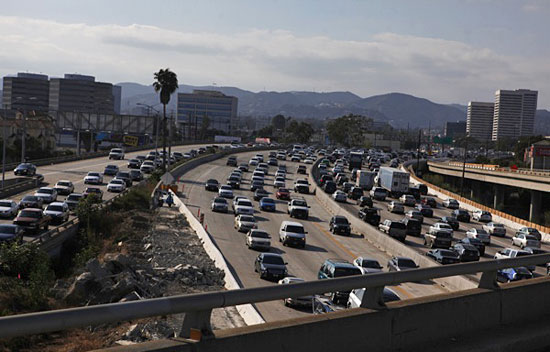
The end is in sight for the 405 Project, with a 10-mile northbound carpool lane set to open next month.
It’s a been a long, hard slog, but the 10-mile carpool lane at the heart of the 405 Project is finally set to open next month, prompting a surge of activity as workers scramble to finish the job.
The latest series of overnight closures, involving all of the 405’s northbound lanes, will run for four successive nights starting tonight, Thursday, April 24, so that workers can install signs over the freeway. Tonight’s closure is from Getty Center Drive to Greenleaf Street, with some ramps closing as early as 7 p.m. and lanes shutting down beginning at 10 p.m. Everything’s expected to reopen by 6 a.m. on Friday. Then, for the next three nights, the action shifts to the northbound lanes between Skirball Center Drive and Greenleaf Street, following roughly the same timetable. Full details are here.
The closures are part of the intensifying effort to finish up the carpool lane, which will represent the final and most significant milestone in the five-year-long project.
Other improvements along the way have included creating wider, safer flyover ramps at Wilshire Boulevard and rebuilding and seismically reinforcing three bridges over the freeway. Landscaping and assorted other finishing-up tasks, including repairing parts of the freeway surface, will still be in the works even after the carpool lane opens next month. But the big goal is in sight and getting closer each day, although the precise date of the opening has not yet been announced.
“There’s a lot of action at the end,” said Mike Barbour, who is managing the effort for Metro. “The importance of making this May date is important to us…You’re getting the intensity of ‘Let’s wrap this up.’ ”
The work plans have generated a seemingly incessant stream of closure notices going out from project officials in recent weeks—and there’s no immediate end in sight.
“There are still a lot more nighttime closures in the next month,” Metro spokesman Dave Sotero confirmed.
And a 55-hour-long closure of a single freeway lane from Sunset Boulevard to Moraga Drive is set to run from Friday, May 2 through the morning of Monday, May 5. (More information is here.)
Even though it’s expected to last for a long time, a single lane closure like that should be a piece of cake for motorists who’ve had to roll with major shutdowns from Carmaggedon to Jamzilla—nicknames that got the public’s attention and helped foster the cooperation needed to accomplish the massive tasks at hand.
“This was always a project of hyperbole, but this was legitimate hyperbole,” Sotero reflected, noting that no other project in memory has affected such a uniquely “geographically constrained” area, the Sepulveda Pass, through which 300,000 motorists pass each day.
“I’m getting the sense that there will be a massive sigh of relief that the lane is open,” Sotero said.
Those who want to learn more about the final phases of the long-running project can attend a community meeting at 6 p.m. tonight at the Westwood Recreation Center, 1350 S. Sepulveda Boulevard.
Posted 4/24/14
Bag bans bring parks a holiday gift
April 24, 2014

Griffith Park Maintenance Supervisor Michael Watkins says the bag measures are "definitely working."
As the guy in charge of picking up Griffith Park’s litter, Michael Watkins usually dreads this week.
“Easter is our busiest day of the year, by far,” says the park maintenance supervisor. “We get about ten times the normal amount of garbage. Doing what I do on the week after Easter is like working at Macy’s on Black Friday or being a tax man on April 15.”
This year, however, the bunny left a pleasant surprise for Watkins: a notable reduction in one of his least favorite trash items—single-use plastic bags.
“That bag ban the city passed is definitely working,” he said. “Usually the wind blows them everywhere—up in the trees, along the fence line. This year, there weren’t as many. I can see a huge difference.”
In January, after years of analysis and discussion, the City of Los Angeles became the largest city in the nation to ban plastic bags. The ordinance made the city one of more than 100 California municipalities to outlaw the flimsy, disposable sacks, which can take centuries to decompose, but which are rarely recycled. Used and tossed by the millions, the bags typically end up in landfills after a single use, or blow out onto the streets, storm drains and beaches, where they endanger fish and wildlife.
At the time, opponents of the ban and representatives of the plastic bag industry argued that the bags’ environmental impacts were overblown. But as the area covered by bans has grown to encompass about a third of California’s population, those on the front lines say they’re beginning to see a difference.
A study done in the aftermath of San Jose’s comprehensive 2012 bag ban found that plastic bag litter had dropped by 89 percent in the storm drain system, 60 percent in creeks and rivers and 59 percent in streets and neighborhoods.
“We’ve been seeing a lot less of them, which is good because they’re a real eyesore,” says Shawn Wright, a maintenance worker at Whittier Narrows Recreation Area in unincorporated Los Angeles County, where a county ban on single use plastic bags has been in place since July 2011.
“Of course, there are still some around, blowing into the lakes and onto the fence line, and we still have all the other debris,” Wright said. As usual, he said, it was taking days to clean up the mess left by the tens of thousands of picnickers who had filled—and refilled—the 15-acre park’s trash bins on Sunday.
“The little plastic eggs, the candy wrappers, the confetti, the watermelon rinds, the mango peels, the aluminum foil from the barbeques, the charcoal bags . . . “
Maintenance workers noted one downside to the bag bans: Without plastic bags to fall back on, picnickers seemed to have fewer options to consolidate their trash.
“People would use them to carry, say, their hamburger buns into the park, and then put their empty Coke cans and napkins and whatever into them and toss them when they were finished,” says Rich Cambaliza, a manager for Rich Meier’s Landscaping in Lancaster, which helps maintain El Cariso Community Regional Park in Sylmar. “They were a pain in the butt, but people did have them when the trash cans overflowed.”
And the bag bans have forced picnickers to improvise with leftovers as well, says Steve Dennis, El Cariso’s landscape contract monitor.
“I’ve been seeing people using our Mutt Mitts—the bags we supply here at the park for dog waste—to take home their leftover barbeque or whatever,” says Dennis, laughing that the trick is giving new meaning to the phrase “doggie bag.”
“Hey, they’re clean and right from the manufacturer. I guess you just have to look past what they’re actually supposed to be used for,” he laughed.
At Griffith Park, Watkins says cleanup crews enlisted the public’s help on Sunday, handing out trash bags and asking them to pitch in. By Tuesday afternoon, he said, the cleanup was almost finished—and he had a new candidate for least-favorite garbage.
“If only we could get people to stop using that damned plastic Easter grass,” he said.
Posted 4/24/14
A high note for mountain protections
April 17, 2014

Ridgeline developments like this will be banned in the Santa Monica Mountains by the county's new rules.
In a vote that will resonate for generations, the California Coastal Commission this week cleared the way for the enactment of a wide-ranging plan to protect the Santa Monica Mountains from development that already has scarred portions of one of the region’s most important environmental and recreational resources.
The 12-member commission voted unanimously in favor of a land use plan adopted last month by the Los Angeles County Board of Supervisors, despite strong opposition from real estate development interests. The Coastal Commission vote was mandated by state law and represents a milestone in the years-long effort to preserve the mountains along the coast as a rural escape for tens of thousands of visitors each year.
The plan will, among many other things, ban ridgeline development, save oaks and other native woodlands, outlaw poisons that can harm wildlife, protect water sources, restrict lighting to preserve the night sky and prevent the opening of new vineyards, which take a toll on the land and water.
“This is a stunning achievement, to get a unanimous vote on a plan that has been on-again, off-again for three decades,” said one of its strongest advocates, Supervisor Zev Yaroslavsky, whose district includes the Santa Monica Mountains. “It’s a tribute to all the stakeholders—environmentalists, equestrians, homeowners, agricultural interests, among others—who came together to find common ground.”
During testimony before the Coastal Commission on Thursday, Yaroslavsky said he had spent two decades on the Board of Supervisors “fighting against ill-conceived developments that have desecrated” the mountains. He told the commission that it now had a “historic opportunity” to stem the damage, an opportunity the commissioners seized.
They left virtually untouched the county’s proposed plan, which was crafted by Yaroslavsky’s office and the Department of Regional Planning. The only substantive addition was a clause that expressly affirmed the right of residents to grow organic gardens through ecologically sound farming methods—a move considered necessary because of misinformation that had been spread about the plan in the days leading up to the commission’s vote.
Much of Thursday’s day-long hearing in Santa Barbara was consumed with people testifying in support of the county’s plan. But one woman used her time to blast the 11th-hour falsehoods aimed at derailing the plan by claiming, among other things, that food gardens would be banned.
“It’s just not fair to those of us who aren’t experts to be given emails that say you’re not going to be able to grow your own food,” said Janet Friesen of the Natural Resources Defense Council. “I’m here to say that I don’t think it’s right when there are paid lobbyists who are misleading people.”
Leading the campaign against the county’s plan, called a Local Coastal Program, was Don Schmitz, a consultant and lobbyist who also owns a vineyard in the Santa Monica Mountains. Under the plan, existing vineyards can remain in business, although no new ones would be allowed to open—a restriction that Schmitz criticized during his testimony on Thursday.
He disputed the negative environmental impacts of vineyards, calling the businesses a “significant draw to the Santa Monica Mountains National Recreation Area.”
“Not everybody is able or even wants to throw on a backpack and do 10 miles on the Backbone Trail,” Schmitz said of one of area’s tougher hikes.
Now that the Coastal Commission has endorsed the plan’s policy direction, it will take another vote in the months ahead on the details of its implementation. The matter will then move back to the Board of Supervisors for a final vote.
Posted 4/11/14
Art that keeps it clean in Malibu
April 17, 2014
Few Malibu visitors look to the city’s storm drains for inspirational scenery. But those mundane slots under the curb have a big job that’s crying out for a little artistic appreciation.
Now it’s getting some. This week, four colorful street murals will be unveiled at storm drains throughout the coastal city, designed and painted by Lindsay Carron, a local artist known for her activism in ecological causes.
The on-the-ground depictions of sea life and rain gardens are part of an ongoing campaign to remind passersby that what falls onto the streets washes into the ocean.
“We needed to communicate this message about protecting areas of environmental significance from urban runoff, and we had already tried the traditional outreach campaigns and typical marketing strategies,” says Casey Zweig, coastal preservation specialist with the city.
“So we thought public art might be something that would grab people and interrupt their regular routine.”
The message is critical along the Malibu coastline, which supports such a diversity of marine life that the state has designated it as one of 34 Areas of Special Biological Significance. The designation, conferred by the state Water Resources Control Board, carries heightened environmental restrictions, particularly on runoff.
From Latigo Point to Laguna Point near Point Mugu, nothing but pure, clean rainwater is supposed to be discharged into the ocean. That means locals have to be constantly vigilant about the ways in which inland pollution can inadvertently be washed down the storm drains and into the water—lawn chemicals that can be carried to the beach on water from a broken sprinkler, for instance. Or soapy, oily water that can flow into the drain when a car is washed curbside. Or the mountains of plastic bags and cigarette butts and foam cups that course down the drains and into the seaweed every time it rains.
The city has come at the problem from a number of angles, ranging from education and outreach to facilities designed to catch and treat runoff before it reaches the beach. Underground biofiltration systems are being built into the natural topography at Wildlife Road and Broad Beach Road to capture and cleanse urban runoff. At Pacific Coast Highway and Cross Creek Road, a vacant lot has been turned into a 15-acre park that doubles as another state-of-the-art runoff cleaning machine. Yet another city program encourages locals to convert traditional landscapes to ocean-friendly rain gardens.
Zweig says the “Keep It Clean, Malibu” public art gambit was among the last to be funded by a 2½-year state grant that the city received to pay for education and outreach, and was inspired by a similar storm drain project in Reno. With approval from the City Council, the city’s Cultural Arts Commission put out a call in February for artists to create art around storm drain inlets at Point Dume Shopping Center, Trancas Park, Cross Creek Road and the corner of Morning View Drive and Philip Avenue.
That call caught the attention of Deborah Collodel, a local art lover who immediately thought of Carron, whose work she had discovered several years ago during a spur-of-the-moment visit to the campus gallery at Carron’s alma mater, Pepperdine University.
“They were looking for a muralist and she immediately came to mind because she has done so much work that combines art with awareness,” Collodel says, adding that she and her husband collect Carron’s work, and have hung it at the Malibu Motel, their local business.
Carron’s activist art ranges from murals in Skid Row and Baja to detailed pen-and-ink renderings of wolves for the California Wolf Center. Now 24 and living in Culver City, Carron says she rushed to meet the entry deadline as soon as her friend called her.
“Mural work is a fantastic way to reach people who wouldn’t necessarily be interested in art, or involved in the art realm,” she says. “And I knew this project would give me the chance to connect with the community.”
Her winning design beat out 17 other contenders for the $3,200 commission, depicting not only what’s at stake—the well-being of Malibu’s dolphins, sharks, sea lions and other marine life—but also a potential solution: drought tolerant rain gardens full of rocks, succulents and colorful wildflowers. The seascapes cover the concrete mouths of the storm drains, while the rain gardens decorate the area above the curb.
Though the official ribbon cutting was set for this week at the project’s Trancas Park location, Carron and the city’s Zweig say they already have gotten positive feedback, not only about the murals but about their theme.
“I did a little research into urban runoff, and wanted to say, OK, what can we do to prevent this,” Carron says. “Rain gardens take in excess water from rain or car washing or dumping, and filter it through the soil, where it can be used by plants instead of draining it into a storm drain. It’s a buffer. I liked the idea because it’s not only simple, but also beautiful.”
Posted 4/17/14
We’re back in the black
April 17, 2014
While expressing concerns about the endurance of the rebounding economy, Los Angeles County’s chief executive has unveiled a proposed budget that confronts some of the county’s biggest challenges and controversies, funding more than 1,300 new jobs to tackle everything from healthcare reform to child protection to oversight of deputies in the jails and on the streets.
Chief Executive Officer William T Fujioka told the Board of Supervisors on Tuesday that his proposed $26 billion spending plan for fiscal year 2014-2015 represents a cautious expansion of county spending that had been cut by an average of 15% during the Great Recession, beginning in 2008-2009. Fujioka said the driving philosophy behind his proposed budget—balanced for a second consecutive year—is “stabilization” and “sustainability” as county revenues continue to rise with the recovery. (Complete budget details can be seen here.)
Just four years ago, the county had its largest budget gap of the recession—$491 million—and was forced to tap reserves to avoid layoffs and deeper service cutbacks. For five years, employee labor unions agreed to zero salary increases to help the county survive the economic crisis. Now, in the proposed budget, $217 million in “unavoidable cost increases” has been earmarked for raises, benefits and retirement costs negotiated with unions as property and sales tax receipts have moved the county out of the red.
In his budget briefings to the board and the media, Fujioka has emphasized that uncertainties at the federal and state levels could substantially change the county’s budget outlook. Only about $6 billion of the county’s $26 billion budget comes from locally generated revenue, such as property tax, which is forecasted to increase by a little more than 4%. The rest comes from state and federal governments.
If approved in June by the board after public hearings and deliberations, the CEO’s proposed budget would not only reverse some cuts made in recent years (county library hours, for example, would be restored to 2009-2010 levels), but also would underwrite reforms in two departments rocked by controversies.
The budget proposes adding 100 new social worker positions and 26 support staff jobs to the Department of Children and Family Services to reduce caseloads and better protect youngsters who come in contact with the county’s child welfare system.
The move to beef up the social worker ranks through a variety of government funding sources gained momentum after several high-profile deaths of abused children galvanized support for broad reforms. According to Fujioka, additional funds also will likely be made available to underwrite recommendations of the Blue Ribbon Commission on Child Protection, which was created by the Board of Supervisors and is now completing its work.
Fujioka’s budget also calls for spending $36.5 million to implement reforms recommended by another board-created panel—the Citizen’s Commission on Jail Violence, which examined allegations of widespread brutality by Los Angeles County sheriff’s deputies inside the county lockup. This funding, along with $20 million in ongoing resources provided during fiscal year 2013-2014, would pay for more supervisors and more rigorous internal oversight, among other things.
What’s more, funding will be made available for more than two dozen positions in the newly created Inspector General’s Office, a key commission recommendation aimed at bringing more oversight and accountability to the Sheriff’s Department.
Not all the new jobs in the budget, however, are being proposed as a response to scandals. Some are meant to be proactive, “providing a strong foundation as we move forward,” Fujioka said.
More than 700 full-time nursing positions are being proposed to help the Department of Health Services meet state-mandated nurse staffing ratios and compete for low-income patients who, under the federal Affordable Care Act, will receive subsidized health insurance. These patients now will be able to seek care elsewhere. And that means a potential loss of revenue to the county. Thus, Health Services is determined to transform the county from a provider of last resort into a provider of first choice.
Fujioka credited the sound fiscal policies of the Board of Supervisors with allowing county government to ride the economic downturn of recent years with a minimum of disruption, unlike other local governments in Southern California and across the nation.
Said Fujioka: “The board’s long-standing conservative budget practices, and our strong compliance to fiscal policies, enabled us to weather these trying economic times.”
Posted 4/17/14
New sheriff writes a new chapter
April 17, 2014
When former Sheriff Lee Baca announced his surprise resignation to a crush of reporters in January, he closed with a heartfelt recitation of the agency’s “core values.”
“As a leader of the Los Angeles County Sheriff’s Department,” he said, his voice wavering with emotion, “I commit myself to perform my duties with respect for the dignity of all people, integrity to do right and fight wrongs, wisdom to apply common sense and fairness in all I do, and courage to stand against racism, sexism, anti-Semitism, homophobia, and bigotry in all its forms.”
It was not the first time the sheriff had publicly, solemnly recited the code. He’d long ago committed the words to memory and had spoken them often during the ups and downs of his tenure—especially during those final months when he and his department were under siege for alleged deputy brutality in the jails.
But now Baca is gone. And so, too, is his code of core values.
On Monday, interim Sheriff John Scott sent out an all-hands email announcing the creation of a new statement, one containing “the same deeply-held values” but expressed in a new way. Scott explained that he’d reached out to a committee of deputies, sergeants and professional staffers to craft the new statement, with its extra emphasis on professionalism, compassion and accountability—words that were absent in Baca’s code.
“I will hold myself accountable for serving our Department and the public in a manner consistent with these values, and I will, in the same way, hold each of you accountable for your actions,” Scott pledged in his department-wide email.
What went unsaid was the subtext. Many in the rank-and-file had come to view the old code as a collection of empty vows, violated by some at the top of the organization, Scott explained in an interview.
The old code had become an example of, “do as I say, not as I do,” Scott said. “That was the driving force [behind the change]. The code should not be just nice words on a wall. It should reflect values you live by in the light of day and in the shadows of darkness.”
The new code was built around six words (one for each point of the badge) that the 12-member committee concluded best described how department members should conduct themselves in the pursuit of their mission, Scott said. Those words were then woven into this short statement:
“With integrity, compassion, and courage, we serve our communities—protecting life and property, being diligent and professional in our acts and deeds, holding ourselves and each other accountable for our actions at all times, while respecting the dignity and rights of all [emphasis included].”
Beyond its statement of guiding principles, the new code also is meant to send a broader symbolic message.
Since his temporary appointment by the Board of Supervisors in late January, Scott has wasted no time dismantling remnants of the Baca Administration that he believes had damaged morale, undermined the department’s effectiveness and broken the public’s trust.
Among other things, he’s shaken up the management ranks, created new internal controls and even banned cigar smoking on a patio at the agency’s Monterey Park headquarters that was frequented by friends of the top brass and had come to represent clubbiness and exclusion.
These actions, like the rewritten statement of core values, will let the troops and the communities they serve know that “this is a new beginning,” said Scott.
Scott has said he wanted to institute these kinds of changes nine years ago, while serving in the department’s command staff. But unable to get Baca’s buy-in, Scott said, he retired in 2005, later becoming the No. 2 official in the Orange County Sheriff’s Department, where he has led reform efforts in that once-troubled agency.
As part of Scott’s deal with the Board of Supervisors, he’ll return to Orange County after voters here elect a new sheriff either in the June primary or a November runoff. The board did not want an interim sheriff to be distracted by a divisive political campaign at a time when the department needed clear, focused direction.
The day after his appointment, Scott said, he shared a private meal with Baca to talk about the future of a department to which both had devoted decades of their lives.
“I told him, ‘There’s going to be some things I do and it’s going to be sensitive to you. It’s not personal. It’s not about me, it’s not about you. It’s about the department.’ ”
Posted 4/17/14
A new Dawn at the museum
April 16, 2014

After overseeing high-visibility projects all over the county, Dawn McDivitt is ready for a new challenge.
Want to explore the Dawn McDivitt map of Los Angeles?
Here’s an itinerary, just for starters:
A gleaming architectural gem (Disney Hall), an international symbol of great music (the Hollywood Bowl shell), a splashy Civic Center hot spot (Grand Park), a state-of-the-art medical facility (LAC+USC Medical Center), an imposing lockup on the outskirts of downtown (Twin Towers Jail), even a tarry pond right beside Wilshire Boulevard, complete with prehistoric mammoth figures (the La Brea Tar Pits lake bed.)
Over more than two decades, McDivitt has managed projects to build, rebuild or revamp all of those, along with numerous other L.A. County facilities ranging from fire stations to swimming pools. It’s an extensive body of work that has served untold tens of thousands of residents and visitors from every walk of life.
While her pivotal role in bringing all those projects to fruition may be little known to the general public, around the county Hall of Administration, McDivitt is something of a capital projects rock star, with her exuberant laugh, infectious enthusiasm (a favorite adjective: “fabulous!”) and widely-respected ability to get things done.
But, after helping guide the course of more than $2 billion in projects as a manager in the Chief Executive Office, the 56-year-old McDivitt is about to notch a new destination on her professional map: the county’s venerable Natural History Museum.
On May 1, she becomes the museum’s chief deputy director, serving as its No. 2 executive under president and director Jane Pisano.
“She has worked on so many major cultural projects in the county. She really understands and values public-private partnerships and getting things done,” Pisano said. “She is going to be such a great fit here.”
In addition to the main museum in Exposition Park, McDivitt in her new position also will oversee the Page Museum at the La Brea Tar Pits and the William S. Hart Ranch and Museum in Newhall.
“For me, it’s a time for something new, and moving outside of the comfort zone,” McDivitt said on a recent sunny afternoon as she left her 7th floor office to walk through one of her signature accomplishments, Grand Park. “Especially when you stop and realize you’ve been in a place for 20 years.”
The attraction—and the challenge—will be learning to lead a new team in a new environment with a lot of new responsibilities, from human resources to technology, along with more familiar duties like overseeing projects.
“I’m looking forward to learning…I always thrive on knowledge, anyway. I think if you continue to learn, you continue to expand as a person,” McDivitt said. Plus, she added: “I think it’s going to be a really cool environment to work down there because I absolutely love history.”
Like many Angelenos, McDivitt has early memories of going to the Natural History Museum and the Page as a child. And in her professional capacity, she got the chance to oversee a challenging project on the Page/Tar Pits grounds in 2011 when it turned out that the lake was seeping oil and gas into storm drains when it overflowed.
She supervised the CEO’s staff in managing the effort to install a new underground water purification system and connect the tar pits lake to the city sewers beneath Wilshire Boulevard.
Fix-it operations are nothing new to McDivitt.
“It’s kind of like that little Dutch boy with his fingers in the dike,” she joked. “There are times that I just want to pull my finger out and see what happens!”
She’s kept trouble at bay countless times, perhaps most prominently when glare from the new Disney Hall was found to be reflecting into nearby condominiums and onto the street. The solution: Workers with hand orbitals sanded down part of the surface.
Then there was the discovery of human remains during construction of LA Plaza de Cultura y Artes. After expert consultation, the bodies and artifacts were reburied in a special memorial garden at the site.
Even Grand Park needed some emergency trouble-shooting after its inaugural event—a big participatory dance-fest—reduced the Performance Lawn to a “mud pit.” (A new underground drainage system is now in place to prevent a repeat performance.)
McDivitt said she has learned how to listen first and let solutions emerge from dialogue.
“Staying calm is a really good challenge to me since I’m Irish,” she said. “So I tend to want to react and solve a problem right off the bat, and think of a solution before I actually listen to everything. My sisters tend to say to me, ‘OK, I’m calling to talk to you and I only want you to listen. Don’t solve the problem. I want you to listen.’ “
McDivitt said she is leaving behind a “great team” to carry on the capital project work, including upcoming phases of the Grand Avenue Project. (A Frank Gehry-designed development to be built across from his acclaimed Disney Hall is expected to come before the Board of Supervisors later this month, before McDivitt departs.)
But she’ll be taking with her something rare and precious: the opportunity to watch in delight as her work took on a life of its own.
“Look how much it’s being used,” she said as she strolled through Grand Park, children frolicking in the fountain and grownups lingering over lattes at café tables. “This is fabulous! That just feels so exhilarating—especially when you’re in the public sector.”
Posted 4/16/14
‘Unseen, unheard and unsafe’
April 11, 2014

Blue ribbon commission chair David Sanders,center, at the meeting Thursday, with Leslie Gilbert-Lurie, left, and retired judge Dickran M. Tevrizian.
Los Angeles County’s child protection system is broken and demands immediate fixes, according to a draft of a new blue ribbon commission report that paints a troubling portrait of dysfunction, secrecy and largely ineffectual struggles to turn the tide on decades of tragedy and trauma.
“On our watch, many of Los Angeles County’s most vulnerable children are unseen, unheard and unsafe,” the report says in its opening sentence. “In eight months of hearing hundreds of hours of testimony, the commission never heard a single person defend our current child safety system.”
The panel issued numerous recommendations, including creation of a powerful “child protection czar”—a single entity responsible for coordinating child welfare efforts across departmental boundaries and reporting directly to the Board of Supervisors.
The commission’s report, approved Thursday in its draft form, will go before the Board of Supervisors on April 22, with a longer follow-up discussion set for May 20.
Philip Browning, head of the Department of Children and Family Services since 2012, said he agrees with some of the report’s assessments, including a finding that persistent turnover in DCFS leadership over the years has “devastated morale and created endless directives.” He said he welcomes the report’s recognition that it takes an array of departments and agencies—not just DCFS—to protect kids.
“The concept of having everybody be responsible is certainly a good one. The problem is…any time we get a new set of recommendations, we do have to pull people off doing whatever they’re currently doing to respond to those recommendations.”
Browning said he wishes the commission had acknowledged recent progress within the department, including a dramatic expansion of training, a plan to hire more staff and reduce caseloads, creation of a foster care search engine, and a new data-driven approach to make DCFS operate more effectively.
“I was a little surprised that they didn’t look more closely at our strategic plan, the first one in 10 years,” Browning said. “A lot of things that they’re talking about are already included in our strategic plan.”
The 10-member commission started work following the death of Gabriel Fernandez, a Palmdale boy who died last year following numerous reports of abuse, neglect and torture. The Board of Supervisors was divided about the necessity of creating the blue ribbon panel in the first place; Supervisors Zev Yaroslavsky and Don Knabe said they wanted to let reforms initiated by Browning have a chance to take root before adding more recommendations to the hundreds that have piled up over the years.
But in the end, all five supervisors appointed members to the panel, including retired judges, a social work educator, advocates for children and families, and a former head of DCFS, commission chair David Sanders.
The commission held 15 public hearings in which it heard testimony about “overwhelming” caseloads, infants spending hours on desks because of a foster home shortage and young people who can’t trust or even reach their social worker.
The draft report depicts a county bureaucracy lurching from crisis to crisis yet failing to coordinate among departments that should be working together. Budget and planning processes are opaque, and communication among those seeking to help children is “needlessly” hampered by various perceived confidentiality restrictions that end up hiding problems instead of correcting them, the report said.
In short, there is “a state of emergency that demands a fundamental transformation of the current child protection system,” the commission found.
It said the Board of Supervisors needs to take action immediately. Commissioners noted that they had provided the board with an interim report in December that included recommendations that could have been implemented at once.
“Since then, another 5,000 referrals of child abuse and neglect have been investigated without the benefit of systemic reform,” the report said. “Each day we wait for reform, 40 more infants are reported as possible victims of abuse or neglect.”
Members of the blue ribbon panel, meeting Thursday at the Hall of Administration, unanimously voted to recommend establishment of a single entity that would oversee all aspects of child protection in the county and have the authority to channel resources across bureaucratic boundaries to get things done.
But commissioners were divided on how best to accomplish that. A majority said a new agency, which could be called the Office of Child Protection, should be formed. But three commissioners said it would be preferable to work within the system and give enhanced responsibility to an existing entity to guide the process.
For his part, DCFS chief Browning said “the devil is in the details” about how such a system would operate.
“I would really like to see somewhere that has worked well. It’s a novel concept,” Browning said. “It’s going to be a potential issue if someone has the authority to move money without much oversight…I would be surprised if the board would give up their authority to do that.”
Beyond its call for placing a single powerful entity in charge, the blue ribbon commission also found that, despite responding to years of crises, the county has failed to establish a clear child protection mission with measurable goals: “The board must mandate that child safety is a top priority,” the draft report said. “It must articulate a child-centered, family-focused countywide mission.”
Part of that mission should focus on protecting children before abuse can happen—something that so far has all too often taken a backseat to reacting to an onslaught of high profile cases, the commission said. That should include pairing public health nurses with social workers on home visits involving infants, creating an “early warning” alert process within the county’s information-sharing Electronic Suspected Child Abuse Reporting System, and focusing intensively on those at highest risk.
“Children reported to DCFS prior to age one are at the highest risk for later serious injury or fatality,” the report said.
The report is still being revised, but this link, posted by KPCC, offers a look at the work in progress prior to Thursday’s meeting.
Posted 4/11/14




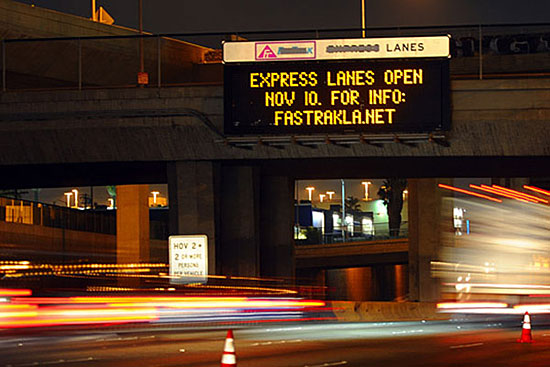




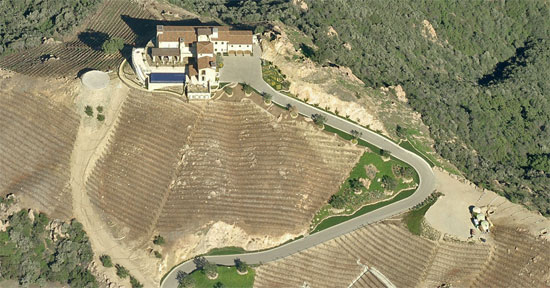
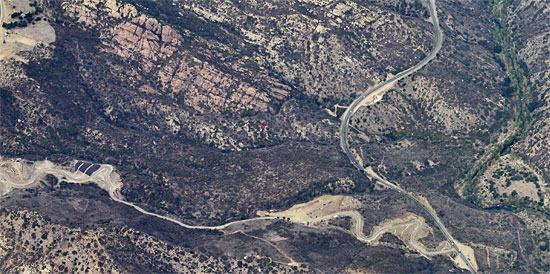
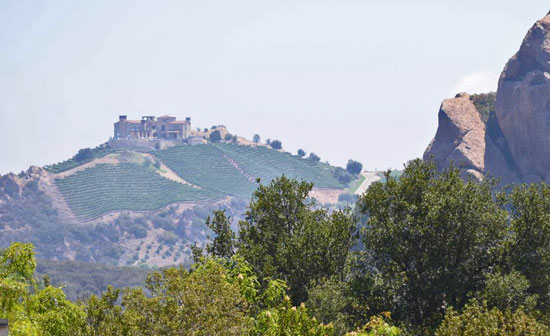



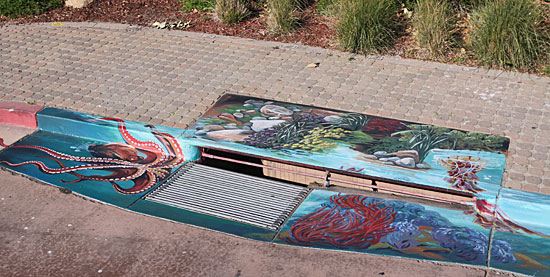

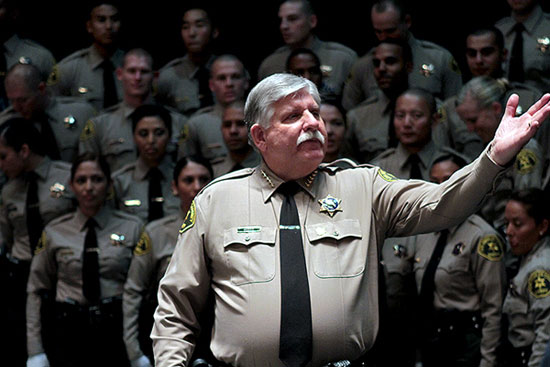






 Check for the latest closure information
Check for the latest closure information








